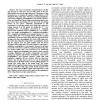Free Online Productivity Tools
i2Speak
i2Symbol
i2OCR
iTex2Img
iWeb2Print
iWeb2Shot
i2Type
iPdf2Split
iPdf2Merge
i2Bopomofo
i2Arabic
i2Style
i2Image
i2PDF
iLatex2Rtf
Sci2ools
ENGL
2007
2007
Cognitive Design Features on Traffic Signs
—The success of effective communication of traffic sign messages to road users may not only relate to the user characteristics but also the signs themselves. The purpose of this experiment was to examine the cognitive design features of 120 Mainland China traffic signs. The features included familiarity, concreteness, simplicity, meaningfulness, and semantic closeness. Forty-one Hong Kong Chinese engineering undergraduates, who have never taken any driving tests, nor possessed any driving licenses in any places, voluntarily participated in this experiment. For each sign, subjects were asked to give subjective ratings between 0 to 100 points for familiarity (0 = very unfamiliar, 100 = very familiar), concreteness (0 = definitely , 100 = definitely concrete), simplicity (0 = very complex, 100 = very simple), meaningfulness (0 = completely meaningless, 100 = completely meaningful), and semantic closeness (0 = very weakly related, 100 = very strongly related). With the exception of famil...
Related Content
| Added | 13 Dec 2010 |
| Updated | 13 Dec 2010 |
| Type | Journal |
| Year | 2007 |
| Where | ENGL |
| Authors | Annie W. Y. Ng, Alan H. S. Chan |
Comments (0)

